Related Research Articles

The Commodore 64, also known as the C64, is an 8-bit home computer introduced in January 1982 by Commodore International. It has been listed in the Guinness World Records as the highest-selling single computer model of all time, with independent estimates placing the number sold between 12.5 and 17 million units. Volume production started in early 1982, marketing in August for US$595. Preceded by the VIC-20 and Commodore PET, the C64 took its name from its 64 kilobytes(65,536 bytes) of RAM. With support for multicolor sprites and a custom chip for waveform generation, the C64 could create superior visuals and audio compared to systems without such custom hardware.

A handheld game console, or simply handheld console, is a small, portable self-contained video game console with a built-in screen, game controls and speakers. Handheld game consoles are smaller than home video game consoles and contain the console, screen, speakers, and controls in one unit, allowing people to carry them and play them at any time or place.
System software is software designed to provide a platform for other software. Examples of system software include operating systems (OS).
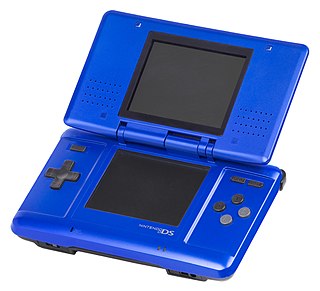
The Nintendo DS is a foldable handheld game console produced by Nintendo, released globally across 2004 and 2005. The DS, an initialism for "Developers' System" or "Dual Screen", introduced distinctive new features to handheld games: two LCD screens working in tandem, a built-in microphone and support for wireless connectivity. Both screens are encompassed within a clamshell design similar to the Game Boy Advance SP. The Nintendo DS also features the ability for multiple DS consoles to directly interact with each other over Wi-Fi within a short range without the need to connect to an existing wireless network. Alternatively, they could interact online using the now-defunct Nintendo Wi-Fi Connection service. Its main competitor was Sony's PlayStation Portable during the seventh generation of video game consoles.
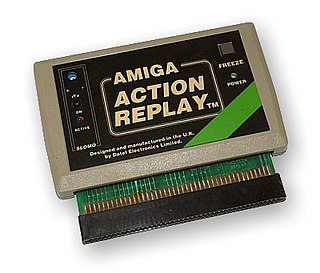
Action Replay is the brand name of a cheating device created by Datel. The Action Replay is available for many gaming systems including the Nintendo DS, Nintendo DSi, Nintendo 3DS, PlayStation Portable, PlayStation 2, GameCube, Game Boy Advance, and the Xbox. The name is derived from the first devices’ signature ability to pause the execution of the software and save the computer's state to disk or tape for future “replay”. The ability to manipulate the contents of memory in this paused state permitted the cheat functions for which the brand is now better known.
The Commodore 64 amassed a large software library of nearly 10,000 commercial titles, covering most genres from games to business applications, and many others.
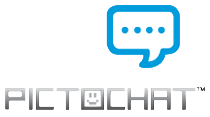
PictoChat is a communication utility that is preloaded on the Nintendo DS, Nintendo DS Lite and Nintendo DSi. Up to sixteen people can paint and/or text chat with each other using it, connected wirelessly through a LAN-only, system-to-system wireless connection. It allows for simple input of keyboard text and written text/drawings. PictoChat received an Excellence Prize for Entertainment at the 2004 Japan Media Arts Festival.
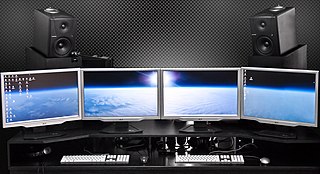
Multi-monitor, also called multi-display and multi-head, is the use of multiple physical display devices, such as monitors, televisions, and projectors, in order to increase the area available for computer programs running on a single computer system. Research studies show that, depending on the type of work, multi-head may increase the productivity by 50–70%.
Homebrew, when applied to video games, refers to games produced by hobbyists for proprietary video game consoles which are not intended to be user-programmable. The official documentation is often only available to licensed developers, and these systems may use storage formats that make distribution difficult, such as ROM cartridges or encrypted CD-ROMs. Many consoles have hardware restrictions to prevent unauthorized development.
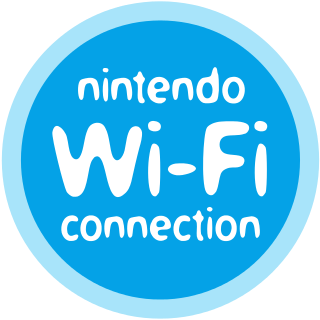
Nintendo Wi-Fi Connection (WFC) was an online multiplayer gaming service run by Nintendo to provide free online play in compatible Nintendo DS and Wii games. The service included the company's Wii Shop Channel and DSi Shop game download services. It also ran features for the Wii and Nintendo DS systems.
This is a list of video game accessories that have been released for the Game Boy handheld console and its successors. Accessories add functionality that the console would otherwise not have.

KORG DS-10 is a music creation program for the Nintendo DS that emulates the Korg MS range of synthesizers. Frequently people refer to the Korg MS-10, however the MS-10 is a single oscillator monosynth. The DS-10 adds sync which the Korg MS-20 is lacking. It was released on July 24, 2008, in Japan, October 10, 2008 in Europe, and November 4, 2008, in the United States.

The Nintendo DSi is a dual-screen handheld game console released by Nintendo. The console launched in Japan on November 1, 2008, and worldwide beginning in April 2009. It is the third iteration of the Nintendo DS, and its primary market rival was Sony's PlayStation Portable (PSP). The fourth iteration, entitled Nintendo DSi XL, is a larger model that launched in Japan on November 21, 2009, and worldwide beginning in March 2010. Development of the DSi began in late 2006, and the handheld was unveiled during an October 2008 Nintendo conference in Tokyo. Consumer demand convinced Nintendo to produce a slimmer handheld with larger screens than the DS Lite. Consequently, Nintendo removed the Game Boy Advance (GBA) cartridge slot to improve portability without sacrificing durability.

The Nintendo DSi system software is a set of updatable firmware versions, and a software frontend on the Nintendo DSi video game console. Updates, which are downloaded via the system's Internet connection, allow Nintendo to add and remove features and software. All updates also include all changes from previous updates.

Art Academy, also known as Art Academy: Learn painting and drawing techniques with step-by-step training in the PAL regions and Artistic Taste Classroom DS in Japan, is an art training software for the Nintendo DS. It was developed by Headstrong Games and published by Nintendo. Art Academy was originally a two-part training application only available for download via the DSiWare service since 2009. It was later re-released in 2010 as a fully compiled, retail-able DS Game Card with added features, thus also making it available for original Nintendo DS and Nintendo DS Lite users.
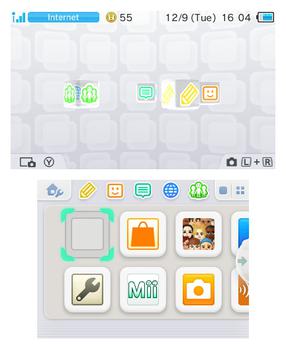
The Nintendo 3DS system software is the updatable operating system used by the Nintendo 3DS handheld system. The Nintendo Switch system software is believed to have evolved from the Nintendo 3DS system software.
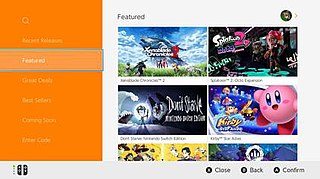
The Nintendo eShop is a digital distribution service for the Nintendo Switch, and formerly available via the Nintendo Network for the Wii U and Nintendo 3DS. The eShop was first launched in June 2011 on the Nintendo 3DS via a system update that added the functionality to the HOME Menu. It is the successor to both the Wii Shop Channel and DSi Shop. Unlike on the Nintendo 3DS, the eShop was made available on the launch date of the Wii U, although a system update is required in order to access it. It is also a multitasking application, which means it is easily accessible even when a game is already running in the background through the system software, though this feature is exclusive to the Wii U and the Nintendo Switch. The Nintendo eShop features downloadable games, demos, applications, streaming videos, consumer rating feedback, and other information on upcoming game releases.

Game-Maker is an MS-DOS-based suite of game design tools, accompanied by demonstration games, produced between 1991 and 1995 by the Amherst, New Hampshire based Recreational Software Designs and sold through direct mail in the US by KD Software. Game-Maker also was sold under various names by licensed distributors in the UK, Korea, and other territories including Captain GameMaker and Create Your Own Games With GameMaker!. Game-Maker is notable as one of the first complete game design packages for DOS-based PCs, for its fully mouse-driven graphical interface, and for its early support for VGA graphics, Sound Blaster sound, and full-screen four-way scrolling.
The Nintendo Network is Nintendo's online service which provides online functionality for the Nintendo 3DS and Wii U systems and their compatible games. Announced on January 26, 2012, at an investors' conference, it is Nintendo's second online service after Nintendo Wi-Fi Connection. Former president of Nintendo Satoru Iwata said, "Unlike Nintendo Wi-Fi Connection, which has been focused upon specific functionalities and concepts, we are aiming to establish a platform where various services available through the network for our consumers shall be connected via Nintendo Network service so that the company can make comprehensive proposals to consumers."
References
- ↑ "Petit Computer - GameBridge". www.gamebridge.co.uk.
- ↑ "Developed in-house". SmileBoom. 18 October 2016.
- ↑ "Developed in-house". SmileBoom. 18 October 2016. Retrieved 30 March 2020.
- ↑ "Company Profile". SmileBoom. 18 October 2016. Retrieved 30 March 2020.
- 1 2 Nintendo Life (24 July 2012). "Petit Computer (DSiWare) Review - Nintendo Life". Nintendo Life.
- ↑ "Sample Program - Petit Computer". Petit Computer. Archived from the original on 17 February 2015.
- ↑ "The problem with programming: my adventure in BASIC with Petit Computer for DS". Pocket Gamer. 7 September 2013.
- ↑ "SmileBASIC". smilebasic.com.
- 1 2 "SmileBASIC Review". Nintendo Life. 15 December 2015.
- ↑ "SmileBASIC is Heading to Wii U, With Cross-Platform Support and DLC Also Confirmed". 17 October 2015.
- ↑ "What's New".
- ↑ "11.1.0-34 - 3dbrew".
- ↑ "プチコン4 SmileBASIC". プチコン4. SmileBoom.
- ↑ ""SmileBASIC 4", a programming tool that allows you to create and play games with Nintendo Switch™ The release date is on April 23, 2020! The official website have been released!". Twitter. SMILEBASIC.com. 16 April 2020.
- ↑ "Developed in-house". SmileBoom. 18 October 2016.
- ↑ "プチコン4とは? | プチコン4 SmileBASIC". プチコン4. SmileBoom.
- 1 2 "Nintendo Switch|ダウンロード購入|プチコン4 SmileBASIC". 任天堂ホームページ (in Japanese). Nintendo.
- 1 2 SMILEBASIC.com (2020-04-29). "[Important Notice] We are currently discussing ratings with IARC on the content of the sample code (GAME_PRG, GAME_SHOOTER) in the title, SmileBASIC 4, so we are temporarily suspending sales in some sales areas (US, CA and Mexico are all still on sale)". @smilebasic_com. Retrieved 2020-05-07.
- ↑ SMILEBASIC.com (2020-06-18). "[News] Today, SmileBASIC 4 is now back on sale in Europe, Australia and other regions! Enjoy the world of SmileBASIC 4!". Twitter. Retrieved 2020-07-11.